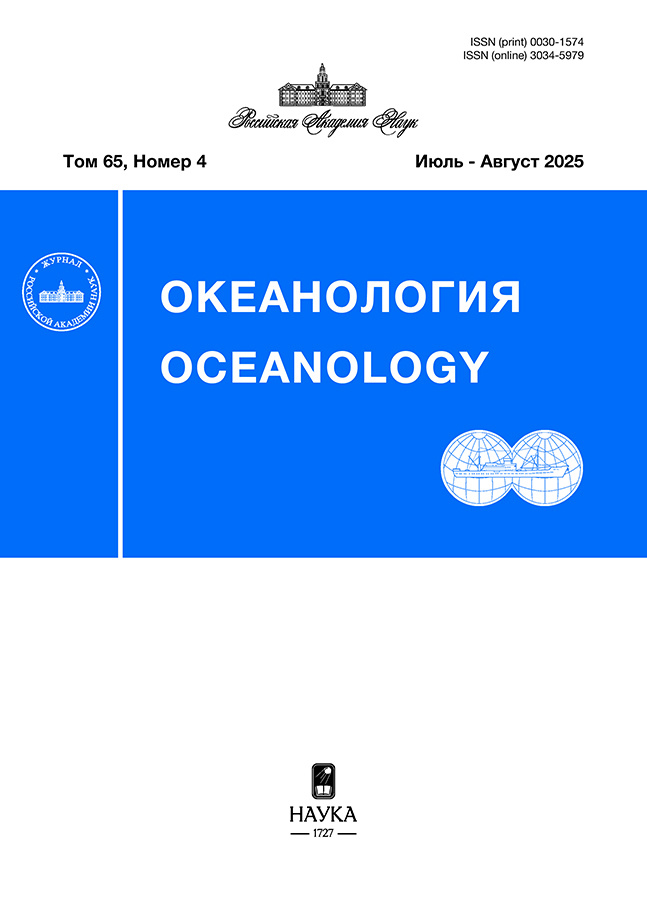Structure of the mid-pacific sea mountains on geomorphological and cosmogeological data
- Authors: Gavrilov A.A.1
-
Affiliations:
- V.I. Il’ichev Pacific Oceanological Institute, Far Eastern Branch, Russian Academy of Science
- Issue: Vol 65, No 4 (2025)
- Pages: 694-709
- Section: Морская геология
- URL: https://journals.eco-vector.com/0030-1574/article/view/692411
- DOI: https://doi.org/10.31857/S0030157425040147
- ID: 692411
Cite item
Abstract
The use of morphostructural analysis and cosmogeological decoding methods by the working with relief digital models (3D) which were created within the Google Earth Pro program framework on the global bathymetric databases and maps (GEBCO_2014, GEBCO_2022 Grid) foundation made it possible to obtain fundamentally new information about qualitative and quantitative characteristics of the Mid-Pacific Seamounts and ocean floor adjacent areas structural elements. It was been established that the under consideration mountains are represented compound complexes of ring and linear groupings of abradated paleovolcanic constructions and other focal structures that form relict magmatic swells and underwater mountain ridges, respectively. Parameters, morphological features and basic regularities of focal structures of different sizes and depths laying location were detected, the network of fracture zones and block morphostructures of the region were briefly characterized. The main factors and mechanisms of mountain formation are associated with mantle diapirism phenomena and scale basaltoid volcanism, which have realized in pulsating regime throughout the Cretaceous period.
About the authors
A. A. Gavrilov
V.I. Il’ichev Pacific Oceanological Institute, Far Eastern Branch, Russian Academy of Science
Email: gavrilov@poi.dvo.ru
Vladivostok, Russia
References
- Артамонов А.В. Подводные горы системы поднятий Маркус-Неккер (Тихий океан): особенности строения и магматизма // Вестник КРАУНЦ. Науки о Земле. 2016. № 3. Вып. 31. С. 40–57.
- Артюшков Е.В. Новейшие поднятия земной коры как следствие инфильтрации в литосферу мантийных флюидов // Геология и геофизика. 2012. Т. 53. № 6. С. 738–760.
- Васильев Б.И. Геологическое строение и происхождение Тихого океана. Владивосток: Дальнаука, 2009. 559 с.
- Брюханов В.Н., Буш В.А., Глуховский М.З. и др. Кольцевые структуры континентов Земли. М.: Недра, 1987. 184 с.
- Гаврилов А.А. Проблемы морфоструктурно-металлогенического анализа. Владивосток: Дальнаука, 1993. Ч. II. С. 141–326.
- Гаврилов А.А. Космогеологическая индикация морфоструктурных элементов побережий и дна прилегающих акваторий (зал. Петра Великого, Японское море) // Океанология. 2021. Т. 61. № 4. С. 633–648. https://doi.org/10.31857/S0030157421040043
- Гаврилов А.А. Актуальные теоретические вопросы геоморфологических и морфотектонических исследований. Владивосток: Дальнаука, 2022. 324 с.
- Гаврилов В.П. Геология и минеральные ресурсы Мирового океана. М.: Недра, 1990. 323 с.
- Говоров И.Н., Говоров Г.И. Симоненко В.П. и др. Анкаромитовая ассоциация гор Маркус-Уэйк (Тихий океан) как показатель погребенных древних структур // Геотектоника. 1993. № 4. С. 87–96.
- Грачев А.Ф. Мантийные плюмы и проблемы геодинамики // Физика Земли. 2000. № 4. С. 3–37.
- Ежов Б.В. Морфоструктуры центрального типа Азии. М.: Наука, 1986. 133 с.
- Ежов Б.В., Никонова Р.И. Морфоструктура дна Северной Пацифики с позиций очаговой геодинамики // Труды професс. клуба. Владивосток, 2004. № 8–9. С. 54–64.
- Международный геолого-геофизический атлас Тихого океана. М. – СПб.: Изд-во ЦКФ ВМФ, 2003. 192 с.
- Мельников М.Е. Месторождения кобальтоносных марганцевых корок. Геленджик: ФГУГП “Южморгеология”, 2005. 230 с.
- Плетнев С.П., Мельников М.Е., Съедин В.Т. и др. Геология гайотов Магеллановых гор (Тихий океан). Владивосток: Дальнаука, 2020. 200 с.
- Пущаровский Ю.М., Меланхолина Е.Н. Тектоническое развитие Земли. Тихий океан и его обрамление. М.: Наука, 1992. 263 с.
- Соловьев В.В., Рыжкова В.М. Морфоструктурный метод изучения глубинного строения литосферы // Труды ЛОЕ. Л.: Изд-во ЛГУ, 1983. Т. 77. Вып. 2. С. 57–62.
- Сычев П.М., Соинов В.В., Веселов О.В. и др. Изостазия сводовых поднятий, хребтов и подводных гор: термальные модели // Тихоокеанская геология 1993. № 1. С. 3–15.
- Gavrilov A.A. The large-scale ring structures of Earth (on data of tectonic geomorphology) // Fourth international conference in Geomorphology. Bologna, Italiа, 28.VIII – 03.IX.1997. 1997. V. 1. Р. 175.
- Gavrilov A.A. The Darvin Rise and geomorphologic-geological indication of focal systems on the Pacific Ocean floor // New Concepts in Global Tectonics (NCGT) Newsletter. 2015. V. 3. № 2. P. 196–207.
- Gavrilov A.A. Ring structures of the Pacific Ocean bottom and some problems with their investigations // NCGT Journal. 2018. V. 6. № 2. P. 172–202.
- Larsen R.L. Latest pulse of Earth: evidence for a mid-Cretaceous superplume // Geology. 1991. V. 19. № 6. P. 547–550.
- Liu M., Chase S.G. Evolution of midplate hotspot swells: numerical solution // J. Geophys. Res. 1989. V. 94. № B5. Р. 5571–5584.
- Morgan W.J. Convection plumes in the lower mantle // Nature. 1971. V. 230. P. 42–45.
- Pollack H.N., Hurter S.J., Johnson J.R. Heat flow from the Earth’s interior: Analysis of the global data set // Rev. Geophys. 1993. V. 31. № 3. P. 267–280.
- Premoli S.I., Haggerty J., Rack F. et al. Proceeding of the Ocean Drilling program. Initial Reports TX – 1993. V. 144. 2148 p.
- Sleep N.H. Hotspots and mantle plumes: some phenomenology // J. Geophys. Res. 1990. V. 95. P. 6715–6736.
- Yano T. Late Mesozoic tectono-magmatism in the West Pacific Ocean – in a linear depression or on a domal uplift? // NCGT Journal. 2014. V. 2. № 4. P. 98–105.
- Батиметрическая карта океанов GEBCO 2013 (http://gebco.net) GEBCO_2014 (WMS) (http://gebco.net) GEBCO_2022 Grid (http://gebco.net›data_and_products/gridded_bathymetry_…)
Supplementary files









